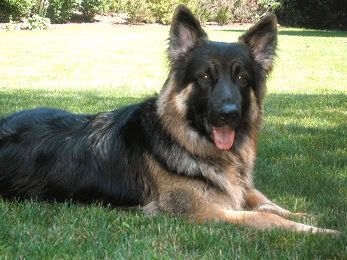First of all, to Bill, I apologize. I read "hunting dogs" and I turned that into "hounds" in my own mind. I forgot there are also pointing breeds and retrieving breeds. <img src="/ubbthreads/images/graemlins/wink.gif" alt="" /> I bet your dog is wonderful. But there is a reason this breed isn't seen in the top levels of protection sports, or make the list for a "protection breed" and that is because they're different than a shepherd or malinois. That's not blasphemy or talking down about your dog, it is simply stating a fact. Just as you'd probably never use a malinois for serious hunting. I love all breeds. But I also recognize all breeds have a purpose, and that purpose differs from breed to breed. So speaking about your dog in the same context as a protection-bred dog (which is what working shepherds and mals are nowadays, since they certainly aren't herders) is not a fair comparison. I apologize for saying hounds, and did not mean it in an insulting way (hey, I LOVE hounds!) but my original statements still apply. Interesting discussion! <img src="/ubbthreads/images/graemlins/smile.gif" alt="" />
13 months, intact, showline history
only dog in household
receives maintenance training 2/day for 10 minutes
received private lessons weekly from 8 weeks to 8 months
lessons now are 1/week with same dog behaviorist in a group
fenced in acre for workouts which he receives w/ ball,etc.
walks every day for socialization from 8 weeks
likes all animals incl. cats & ferrets
loves dogs and people...
Hi Judy, I will give you the best evaluation I can right now over the internet. <img src="/ubbthreads/images/graemlins/smile.gif" alt="" />
First of all, he is young. He's got a LOT of maturing to do. Some lines of GSD don't mature in their defensive nature until after 3 years, and some start as early as 6 months of age. Neither is incorrect, though working folks like a dog who matures quicker so they can progress at beyond a snail's pace. While show folks tend to not mind a dog who's suspicion doesn't develop until after he's done in the show ring, for obvious reasons. That's personal observation. <img src="/ubbthreads/images/graemlins/smile.gif" alt="" />
As far as "showline" goes, that means little by way of temperament at THIS level. I've seen calm dogs come out of show lines, and neurotic fear-biters come out of the same kennels. So it isn't fair to make blanket statements. By what you say, your dog is definitely strong of nerve and NOT sharp. In fact, I'd venture to say he would not be "sharp" enough for serious protection work. Do you wonder sometimes if he'd actually have to be clobbered before he would know someone was a threat? For a working dog, nope not suitable. But for a pet?! Probably you lucked out and got a FABULOUS dog and for that I am glad for you. <img src="/ubbthreads/images/graemlins/smile.gif" alt="" />
I don't think you will have ANY trouble getting what you want (I teach a "watch 'em" command too) but still believe a certain level of bitework is going to be important to maintain stability. If you decide not to do the bitework, then don't even START into protection. I mean, having someone once or twice come out and have your dog scare them away is one thing. That won't ruin him. But organized sessions over a period of weeks/months is going to cause you problems, IMO.
You will find what you're looking for both at a SchH club and at a trainer who is willing to work with you through the levels of alert and simple on-lead biting. I personally like to add the control of off-lead bitework, sending the dog from a distance, and call-off (where you send the dog, then stop him before he bites) as while you would never send your dog in real life, the call-off is invaluable.
Basically, I believe if you're gonna teach your dog to bark convincingly and threateningly, then you better let him bite to relieve the stress... And if you let him bite, you better teach him when and when not to bite. Then you have bitework. There really is no middle ground there. No one says you have to take your dog to the most elite levels of sport, but the below should be part of his training, if you're going to do it at all:
1. Bark threateningly (watch 'em)
2. Simple arm bite on-lead on an attack command or assault
3. Simple out and guard/bark or return to heel/sit/down
4. Send the dog at least 30' for a bite
5. Out and guard as well as out and return to handler
6. Call-off from the bite/sit/down/return to handler
The reason I like to see the send to bite taught is so that the out from a distance and call-off can be taught. They cannot be taught without it, and not all dogs will generalize which CAN cause problems if you want your dog to ever STOP biting and you're not within 5' leash distance. If you don't do the above, don't start at all.
Now, MANY people go further, adding multiple attackers, distractions, environmentals and vehicle work. You can do that too if you like, but the above is the bare-bones basics the dog should know. IMO.
Any other questions, don't hesitate to ask. <img src="/ubbthreads/images/graemlins/smile.gif" alt="" />
 Previous Topic
Previous Topic Index
Index Next Topic
Next Topic












 Top
Top




